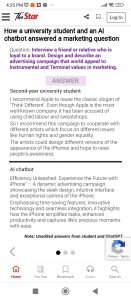Ashley Kam Cheuk, a second-year marketing student at the Hong Kong University And Technology, was assigned to design an advertising campaign for a brand using concepts taught in class. The 20-year-old wrote a 600-word article that proposed Apple should use its famous “Think Different” to generate equality and human rights in addition to its iPhone goods. Then she asked ChatGPT, a generative artificial intelligence (AI) program that was developed last year.
Almost instantly, a campaign plan that was cohesive and entitled “Efficiency Unleashed: Experience the Future with iPhone” very immediately. “AI did a better job than me in naming the campaign, but some of its paragraphs were too repetitive and less creative.” Almost all of Hong Kong’s universities have adopted generative tools for the upcoming academic year because of the rapid advancement of AI. The software is designed to trawl available information or have data fed into it and answer questions; ChatGPT, created by AI, can interact with humans and generate essays from web content.
In addition, to change the teaching methods, academics navigating the uncharted waters of AI claimed they needed help ensuring the students acknowledged the use of the technologies. For any university to bring changes in their curriculum, it takes almost 6 months. Similarly, the University of Hong Kong reversed a ban imposed in February and will enable students to access AI platforms for classroom assignments from this month.
Comparison Between A Student Answer And an AI Chatbot Answer
Microsoft, a tech company backed by OpenAI, has announced that it plans to join forces with eight universities in Hong Kong to provide academic solutions and train people to use AI effectively. Moreover, HKUST permitted students to use GPT-4, the latest AI model developed by OpenAI that can produce text content, and DALL-E-2, which can turn ideas into AI-generated images. The primary issue is plagiarism and assessing originality, as they assumed many students need help from AI-driven chatbots.
Chung Shan-shan, a senior lecturer of environmental and public health management at Baptist University, stated, “I tried uploading two essays to five different (pieces of plagiarism) detection software, and all the ‘similarity percentages’ were different.” “It is challenging to judge whether a student used generative AI.” Many software, such as Turnitin, are available to check human written content accuracy. One of the Chinese universities also developed a plagiarism detection system called VeriGuide.
Moreover, with the help of a token system created by the university, Baptist University students are currently permitted to use the GPT-3.5 model. However, they must declare when they used generative AI for a task, name the tool they employed, and identify portions of an essay that AI produced. According to her, she had also revamped her teaching methods and added informal current affairs tests on the subject in the news. She also stated, “One limitation of AI tools was that they relied on available, outdated information online, which became apparent when students attempted to answer questions on more up-to-date topics.”
GPT-4 is based on information available online up to September 2021. According to the senior accounting teaching fellow Bruce Li Kar-lok of Polytechnic University (PolyU), he was less worried and stated that “the ability of students still trumped chatbots in his discipline, ChatGPT got only two out of six questions correct in an assignment he designed on the calculation of shares and changes related to dates, prices, interest, tax, and dividends.”
Li explained that AI software can handle complex tasks but needs help figuring out the logic behind complex questions. “AI chatbots are like primary level students … They need us to teach them logic”.
In addition, he also stated that” he had found that students were more willing to interact and ask questions in classes after they had used AI tools that provided “conversational feedback” to prepare for classes; before entering the class, students can use chatbots to clarify complicated concepts quickly. This allows deeper discussions as we can save time explaining concept”.
Senior lecturer Jean Lai Hok-yin, a researcher of e-learning systems and intelligent agent technologies at Baptist University’s Department of Computer Science, is an intelligent person who said that the decision by the institutions to access AI tools was less about technological advancement and will enable students to chase the race.
She also said, “These AI-driven tools are unstoppable. When they become an essential part of daily life and work, constructing effective prompts will be very important”.
Read more:
How Demonic Loan Apps Are Cashing On the Failing Economy Of Pakistan
The Amazing AI Tool Can Recreate Mesmerizing Images Of You: Bye Bye Photographers








 List of All the Electric Vehicles Options Available For Pakistani Customers
List of All the Electric Vehicles Options Available For Pakistani Customers